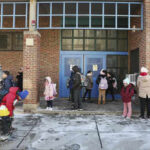The Trump administration‘s recent move to dismantle a decade-old policy shielding “sensitive locations,” like schools and churches, from immigration raids has sparked significant controversy. On January 21, the Department of Homeland Security (DHS) announced the rollback of the Obama-era “Sensitive Locations Guidance,” which had protected educational institutions from Immigration and Customs Enforcement (ICE) and Customs and Border Protection (CBP) enforcement actions. This policy, in place since 2011, was designed to avoid disrupting critical public services and protect vulnerable communities from the disruptive effects of immigration enforcement. Now, with this policy gone, ICE and CBP have the green light to carry out arrests, searches, and surveillance even in previously protected zones such as school campuses.
Trump’s high-handed approach finds no public support
The decision has faced significant public backlash, particularly in the context of education. While the administration justifies the rollback as necessary for enforcing immigration laws and curbing criminal activity, many Americans believe it undermines the safety and well-being of students. According to a recent poll by the Associated Press-NORC Center for Public Affairs Research, 6 in 10 Americans oppose allowing arrests at sensitive locations like schools and churches. The survey, conducted from January 9 to 13, revealed that while many Americans support stronger border security and deportations of violent criminals, the public strongly rejects the idea of immigration enforcement in places where children and families should feel safe.
The public’s concerns are not unfounded. The new policy could lead to a heightened sense of fear and insecurity within school communities, especially for immigrant students and their families. A substantial 70% of respondents in the poll expressed that they oppose the idea of ICE or CBP agents arresting children or parents at school, underscoring the broader unease about immigration enforcement in educational spaces.
Impact on schools and students
For educators and students, the rollback could introduce a climate of fear and uncertainty into classrooms. The presence of immigration officers on school campuses could disrupt daily activities, affect students’ sense of security, and undermine trust between immigrant families and schools. Reports from the Associated Press indicate that between 2017 and 2020, ICE attempted over 60 arrests near sensitive locations, including schools, though many of these attempts were blocked by existing protections.
For many families, this new approach could mean the difference between attending school without fear and facing potential separation from loved ones. This could lead to a dramatic decline in school attendance among immigrant students, as families weigh the risks of attending classes amidst heightened enforcement measures.











